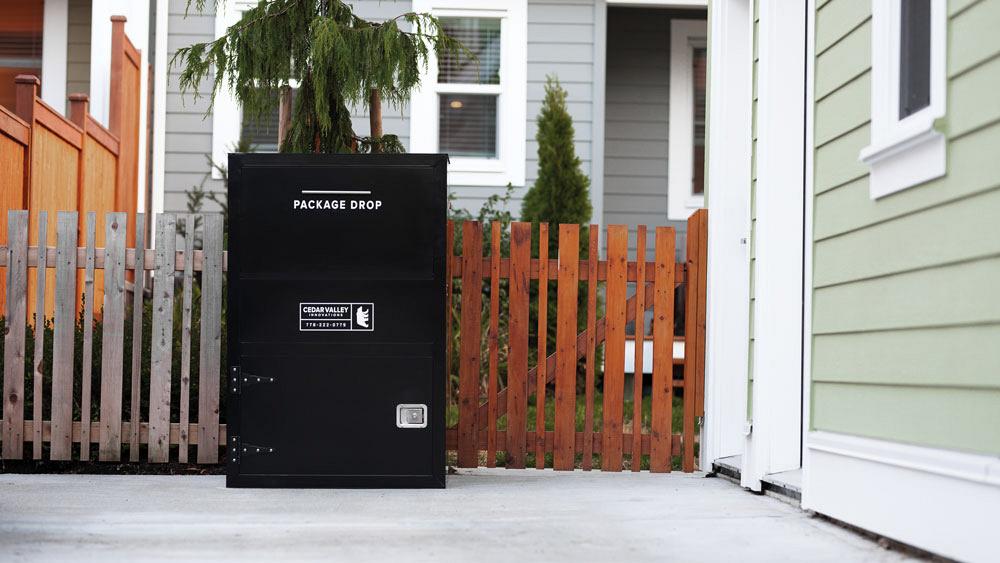Editor
- FMA
- The Fabricator
- FABTECH
- Canadian Metalworking
Boxing the boxes at Cedar Valley Innovations
Mission B.C. shop finds a niche in a delivery-heavy world
- By Rob Colman
- July 1, 2022
- Article
- Fabricating

The concept of the package delivery box arose through a gate contract Matt LaHay was working on last year. Images: Cedar Valley Innovations
An inevitable result of being stuck in your house for months at a time is that you are going to shop online. According to Statistics Canada, retail e-commerce sales almost doubled between February and May 2020 when they reached a record $3.9 billion. That’s a lot of packages being delivered every day. Between the fear of porch pirates and the Canadian weather, some online shoppers are likely to be concerned about how their packages get into their houses safely. Mission, B.C.’s Cedar Valley Innovations created a solution.
Gates to a Prototype
Cedar Valley is a one-man shop, created and operated by Matt LaHay to build what his website refers to as a “secure package delivery system”—essentially, a mailbox big enough and secure enough for many of the parcels we receive regularly.
LaHay has spent the past four years as an independent contractor building custom driveway gates for clients in and around Vancouver.
“My cousins build fences, so anytime they had a customer who wanted gates, they’d call me, and I’d return the favour when I could,” he said. “Among my customers, some would often complain about packages getting stolen or broken. I didn’t think much of it until about eight months ago when I was building a gate for a customer and they realized that the gate would be an issue for deliveries. They asked if I could design a secure box for those deliveries.”
LaHay went to the drawing board to see what he could come up with. This particular customer decided against having a box built, but LaHay saw the potential and went ahead and built a prototype for himself.
“That original design is still sitting outside our front door,” he said. “It evolved quickly from that rough prototype—I created nice cross bends on the doors to give it a more robust look, and the lines of the box itself are pristine in comparison—but it works, and I’ve had a number of delivery people knock on the door to tell me how impressed they are by it.”
Design Details
The design is reminiscent of a standard mailbox but with a larger drawer in which to deposit packages. It measures 48-in. tall by 32-in. wide by 24-in. deep with a sloped top so that moisture doesn’t pool on it in the rain or snow. The box is made from mild steel except for the stainless steel inset lock mechanism at the bottom.
“People ask why I don’t make them out of aluminum,” LaHay said. “But I’ve done a lot of work in aluminum in shops in the past and find that it breaks down and cracks. If you look at clothing donation boxes made of aluminum, after a few years their doors are broken because of the material they’re made from.”
It’s early days for Cedar Valley Innovations. LaHay has his own three-bay shop, but it was strictly designed for the welding work he has been doing over the past four years. For now, once he gets an order for 10 boxes, he rents out space from a friend who has a shear and a press brake, hires on a second fabricator, and spends two days cutting and forming the product.
“Ultimately, once sales increase I want to invest in my own brake,” he said. “But we have to get more orders before we’ll be ready for that.”

“The door through which you drop the package is designed to be easy to open—when you open it, it will stay open if you need to use two hands to insert the package—and when you close it, it closes slowly, like many kitchen cabinets do, and holds firmly closed,” said LaHay.
It’s important to LaHay that the boxes stand the test of time, so he’s careful about how he constructs and paints them.
“Because almost everything is pop riveted together, I need to make sure the material is powder coated so that there is no exposed steel,” he said. “What I do is build a box, putting it together with temporary rivets. Once all the holes are drilled and everything operates properly, the box is completely disassembled and goes to get sandblasted, powder coated, and then reassembled. It means there is less chance that there is any exposed steel.”
The front face for the framework of the doors is made of 2 in. by 2 in. angle welded together. The doors are made using 12-ga. steel and the rest of the body is 14-ga. steel.
For security, LaHay designed a hinge that can only be accessed via the bottom door, which can only be opened with a key, “just in case someone got cute and had the idea of taking the doors off to get at the packages,” he said.
“The door through which you drop the package is designed to be easy to open—when you open it, it will stay open if you need to use two hands to insert the package—and when you close it, it closes slowly, like many kitchen cabinets do, and holds firmly closed,” he said.
Market Expansion
Even though the product is fairly new, the feedback from customers—and delivery people—has been positive.
“Every customer I’ve sold to has been thrilled,” said LaHay. “It’s a great start. I still do the odd custom fab jobs to pay the bills right now, but my fiancée, Stephanie Modenese, who is in promotional work, really pushed me, saying I had to stay focused on this product if I’m going to make a go of it.”
Modenese is helping the cause, managing his website and social media to give Cedar Valley a brand design that stands out.
The key now is finding markets beyond homeowners.
“I’m looking at expanding into schools that need delivery boxes,” he said. “It’s also useful for businesses. After all, some delivery companies run seven days a week; it’s helpful to have a secure method for receiving items when you are not at the office.”

Access to packages is made through the base of the unit, which opens using a key. LaHay designed a hinge for the drop box door that can only be accessed from below, discouraging potential thieves from attempting to break the unit open.
Some people accentuate security issues, but LaHay just sees his product as a better, cleaner way to manage large mail.
“It just looks nicer and keeps everything organized,” he said. “And you don’t have to worry about rushing home because a package is coming. You know your package isn’t going to be out in the rain. It’s peace of mind.”
Editor Robert Colman can be reached at rcolman@canadianfabweld.com.
Cedar Valley Innovations, www.cedarvalleyinnovations.com
About the Author

Rob Colman
1154 Warden Avenue
Toronto, M1R 0A1 Canada
905-235-0471
Robert Colman has worked as a writer and editor for more than 25 years, covering the needs of a variety of trades. He has been dedicated to the metalworking industry for the past 13 years, serving as editor for Metalworking Production & Purchasing (MP&P) and, since January 2016, the editor of Canadian Fabricating & Welding. He graduated with a B.A. degree from McGill University and a Master’s degree from UBC.
subscribe now


Keep up to date with the latest news, events, and technology for all things metal from our pair of monthly magazines written specifically for Canadian manufacturers!
Start Your Free Subscription- Industry Events
Automate 2024
- May 6 - 9, 2024
- Chicago, IL
ANCA Open House
- May 7 - 8, 2024
- Wixom, MI
17th annual Joint Open House
- May 8 - 9, 2024
- Oakville and Mississauga, ON Canada
MME Saskatoon
- May 28, 2024
- Saskatoon, SK Canada
CME's Health & Safety Symposium for Manufacturers
- May 29, 2024
- Mississauga, ON Canada




















